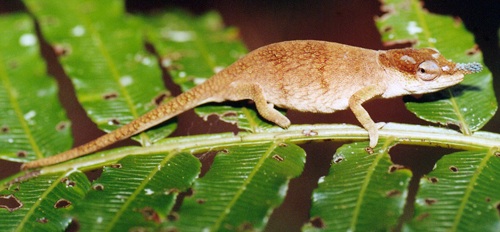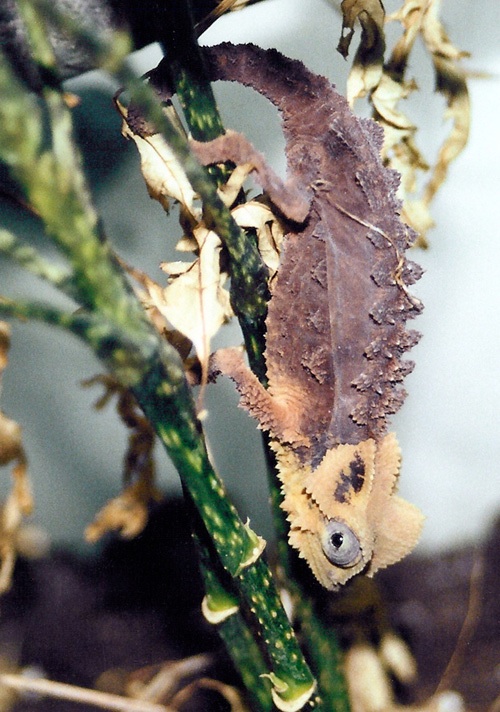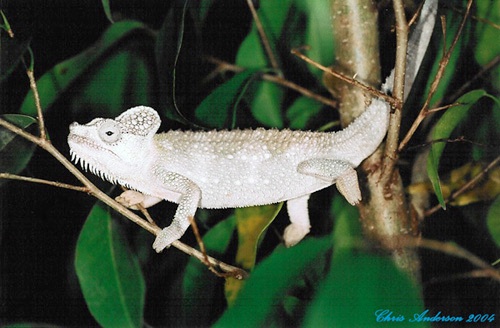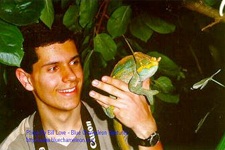



Captive Chameleon Populations
By Christopher V. Anderson
Citation:
Anderson, C.V. (2006). Captive Chameleon Populations. Chameleons! Online E-Zine, May 2006. (http://www.chameleonnews.com/06MayAndersonCaptivePopulations.html)
In a perfect world, people would learn from their mistakes and make conscious efforts to ensure that these mistakes don't repeat themselves. Obviously, there are some situations that individuals, even when organized in groups, can have no control over. Clearly though, one would hope that any possibility to minimize damage from these uncontrollable circumstances would be seriously addressed and efforts made to make the best out of what might simply be a bad situation. This is especially true when these situations are not new and the fallout effects are well known.
In January 1995, the Standing Committee of CITES (Convention on International Trade in Endangered Species) issued a notification to the Parties recommending that the importation of all Chamaeleo species (now regarded as Calumma and Furcifer species) from Madagascar be suspended with the exception of lateralis, pardalis, oustaleti and verrucosus. In accordance with CITES policy, such a notification requires all CITES Party nations to adhere to the recommendation. Since that time, the legal importation of all Malagasy Calumma and Furcifer species out of Madagascar, except for the above mentioned species, has been prohibited. Shortly after the ban, those species that were no longer imported from Madagascar became nearly unobtainable and within a few years, there were almost no legal specimens of most of those species left in the US. Prior to the ban, Calumma p. parsonii was imported in such numbers that they sold for $100 or less but currently, if you can find them to start with, they can fetch $2500-$3000 each! Most serious chameleon keepers would do almost anything for the chance to work with some of these species again and they probably never will legally.

Male Calumma boettgeri. Photo courtesy of Chris Anderson
In November 2002, CITES placed Brookesia perarmata on CITES appendix I. This essentially bans all international trade in the species except possibly for some scientific reasons. Shortly after this went into effect and the species was no longer imported, the species ceased to be sold in the US and has since all but vanished from captive collections. Prior to being placed on appendix I, this species was regularly imported and sold frequently for less then $100 each.

Brookesia perarmata. Photo courtesy of Chris Anderson
Neither of the above mentioned trade bans were unanticipated and in both cases, specimens continued to be imported for a period of time after word was given of the upcoming trade changes. Regardless, efforts in the US to establish viable breeding groups and cooperative breeding efforts were poorly orchestrated and with the exception of Calumma p. parsonii, completely failed. The success of such efforts with Calumma p. parsonii can be hotly argued but the bottom line is, for whatever reason, enough successful effort was made with this species that a few still persist today in US collections and occasionally breed. This is not to say it is overall a success story, however.
So why did keepers and breeders fail to maintain the vast majority of these species in captivity? With the exception of the occasional and generally isolated effort to breed these various species, many were kept much as many other species are kept today-with little or no effort to actively breed, exchange bloodlines or openly seek out and communicate with others working with the same species, let alone try to establish formed breeding cooperations. Yeah, maybe some aspects of our husbandry wasn't as good at the time and maybe some aspects of the importation process were worse then they currently are but I would maintain that much of it has to do with a lack of seriousness by the majority of the chameleon community in the US.
Clearly some species are more difficult to keep than others and many are much more difficult to breed then others. Obviously this is going to greatly influence the success of anyone's breeding efforts and may even lead to some instances that just fail, despite all efforts made. These are unfortunate cases, of course, but can be minimized with a level of seriousness and organization that seeks to establish viable breeding efforts for various species.
In recent years, Uganda imports were available including Bradypodion xenorhinum, Chamaeleo (Trioceros) ellioti, Ch. (T.) hoehnelii and Ch. (T.) johnstoni. Now, having not seen a Uganda shipment in about a year and a half, the captive populations of each of those species in the US is dangerously low and moving toward disappearing. The existence, frequency and size of future shipments from Uganda are honestly unknown, despite efforts to bring more in.

Male Ch. (T.) hoehnelii. Photo courtesy of Chris Anderson
For a number of years, Cameroon species were difficult to acquire until additional shipments came in. While many recent shipments are actually coming from surrounding countries and have been coming in more frequently as of late, the risk of shipments slowing or even stopping are significant and none of these species are bred in the US in numbers great enough to maintain a long term captive population.
Tanzania has long been a source of huge chameleon shipments into the US. While the occasional captive breeding of a species here and there has occurred, there has been little successful consistent breeding in the US. Thus far this year, shipments have slowed and as of this writing, appear to have only been coming in under last year's export permits. While CITES has issued the export quotas, sources have indicated that the Tanzanian government has not issued export licenses and the result has been a drastic decrease in exports. If nothing else, this should serve as an alarm bell to the breeding community that this source of animals is unstable!
It isn't a matter of whether or not we are going to lose the ability to obtain specimens from some of these sources; it's a matter of when, whether we will have any warning or if it's already too late in some cases. As breeders and keepers in the US, we are watching as these markets move closer and closer to closure and little is being done to establish viable, sustainable breeding colonies for the majority of these species. Failing to get serious and put forth an active effort to sustain these species in captive populations will only end in a repeat of that which we've already experienced with Madagascar in past years.
The means to help promote viable captive populations are available and need to be utilized in a manner that will hopefully establish sustainable colonies of various species. Bloodline tracking databases have been created to aid in bloodline management, additional specimen location and breeder communication. Extensive information sources have been and are being created to provide accurate information to assist others working with various species. Online forums and email lists have been created to promote keeper communication on various experience and focal levels. Despite these resources and regular importation of specimens into the US, the overall occurrence of successful breeding, bloodline exchange and open communication for the majority of species has not improved.
While some of the most applied efforts may fail to succeed in establishing long term viable captive populations for some species, the time has come for US keepers and breeders to recognize the potential risk and actively work toward a common goal.
Those seeking additional information about bloodline database locations, forum or email list locations or seeking to contact others working with given species may contact Chris at Chris.Anderson@chameleonnews.com
References:
CITES Notification to the Parties 1990-1995 # 833. Available online at: http://www.cites.org/eng/notif/1995/833.txt Accessed 4/6/06.

Christopher V. Anderson

Chris Anderson is a herpetologist currently working on his Ph.D. at the University of South Florida after receiving his B.S. from Cornell University. He has spent time in the jungles of South East Asia, among other areas, aiding in research for publication. He has previously traveled throughout Madagascar in search of, and conducting personal research on, the chameleons of the region. He has traveled to over 35 countries, including chameleon habitat in 6. Currently, Chris is the Editor and Webmaster of the Chameleons! Online E-Zine and is studying the kinematics and morphological basis of ballistic tongue projection and tongue retraction in chameleons for his dissertation. Chris Can be emailed at Chris.Anderson@chameleonnews.com or cvanders@mail.usf.edu.









Join Our Facebook Page for Updates on New Issues:
© 2002-2014 Chameleonnews.com All rights reserved.
Reproduction in whole or part expressly forbidden without permission from the publisher. For permission, please contact the editor at editor@chameleonnews.com
